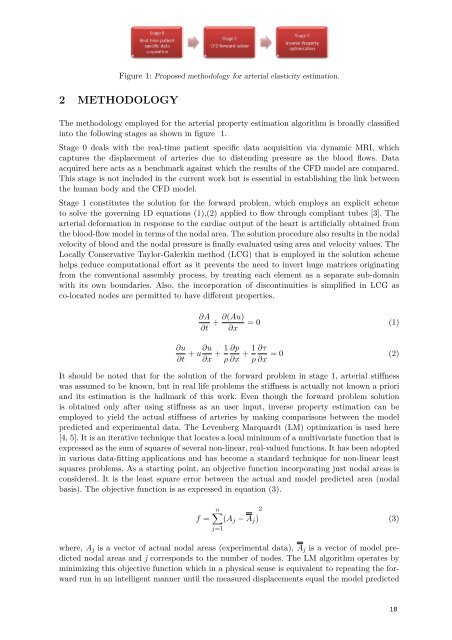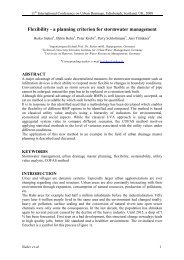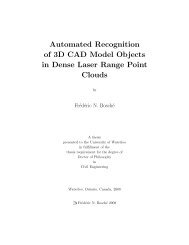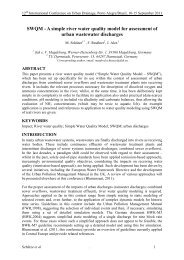ACME 2011 Proceedings of the 19 UK National Conference of the ...
ACME 2011 Proceedings of the 19 UK National Conference of the ...
ACME 2011 Proceedings of the 19 UK National Conference of the ...
Create successful ePaper yourself
Turn your PDF publications into a flip-book with our unique Google optimized e-Paper software.
Figure 1: Proposed methodology for arterial elasticity estimation.<br />
2 METHODOLOGY<br />
The methodology employed for <strong>the</strong> arterial property estimation algorithm is broadly classified<br />
into <strong>the</strong> following stages as shown in figure 1.<br />
Stage 0 deals with <strong>the</strong> real-time patient specific data acquisition via dynamic MRI, which<br />
captures <strong>the</strong> displacement <strong>of</strong> arteries due to distending pressure as <strong>the</strong> blood flows. Data<br />
acquired here acts as a benchmark against which <strong>the</strong> results <strong>of</strong> <strong>the</strong> CFD model are compared.<br />
This stage is not included in <strong>the</strong> current work but is essential in establishing <strong>the</strong> link between<br />
<strong>the</strong> human body and <strong>the</strong> CFD model.<br />
Stage 1 constitutes <strong>the</strong> solution for <strong>the</strong> forward problem, which employs an explicit scheme<br />
to solve <strong>the</strong> governing 1D equations (1),(2) applied to flow through compliant tubes [3]. The<br />
arterial deformation in response to <strong>the</strong> cardiac output <strong>of</strong> <strong>the</strong> heart is artificially obtained from<br />
<strong>the</strong> blood-flow model in terms <strong>of</strong> <strong>the</strong> nodal area. The solution procedure also results in <strong>the</strong> nodal<br />
velocity <strong>of</strong> blood and <strong>the</strong> nodal pressure is finally evaluated using area and velocity values. The<br />
Locally Conservative Taylor-Galerkin method (LCG) that is employed in <strong>the</strong> solution scheme<br />
helps reduce computational effort as it prevents <strong>the</strong> need to invert huge matrices originating<br />
from <strong>the</strong> conventional assembly process, by treating each element as a separate sub-domain<br />
with its own boundaries. Also, <strong>the</strong> incorporation <strong>of</strong> discontinuities is simplified in LCG as<br />
co-located nodes are permitted to have different properties.<br />
∂u<br />
∂t<br />
∂A<br />
∂t<br />
+ u∂u<br />
∂x<br />
+ ∂(Au)<br />
∂x<br />
= 0 (1)<br />
1 ∂p 1 ∂τ<br />
+ + = 0 (2)<br />
ρ ∂x ρ ∂x<br />
It should be noted that for <strong>the</strong> solution <strong>of</strong> <strong>the</strong> forward problem in stage 1, arterial stiffness<br />
was assumed to be known, but in real life problems <strong>the</strong> stiffness is actually not known a priori<br />
and its estimation is <strong>the</strong> hallmark <strong>of</strong> this work. Even though <strong>the</strong> forward problem solution<br />
is obtained only after using stiffness as an user input, inverse property estimation can be<br />
employed to yield <strong>the</strong> actual stiffness <strong>of</strong> arteries by making comparisons between <strong>the</strong> model<br />
predicted and experimental data. The Levenberg Marquardt (LM) optimization is used here<br />
[4, 5]. It is an iterative technique that locates a local minimum <strong>of</strong> a multivariate function that is<br />
expressed as <strong>the</strong> sum <strong>of</strong> squares <strong>of</strong> several non-linear, real-valued functions. It has been adopted<br />
in various data-fitting applications and has become a standard technique for non-linear least<br />
squares problems. As a starting point, an objective function incorporating just nodal areas is<br />
considered. It is <strong>the</strong> least square error between <strong>the</strong> actual and model predicted area (nodal<br />
basis). The objective function is as expressed in equation (3).<br />
n�<br />
2<br />
f = (Aj − Aj)<br />
j=1<br />
where, Aj is a vector <strong>of</strong> actual nodal areas (experimental data), Aj is a vector <strong>of</strong> model predicted<br />
nodal areas and j corresponds to <strong>the</strong> number <strong>of</strong> nodes. The LM algorithm operates by<br />
minimizing this objective function which in a physical sense is equivalent to repeating <strong>the</strong> forward<br />
run in an intelligent manner until <strong>the</strong> measured displacements equal <strong>the</strong> model predicted<br />
(3)<br />
18













